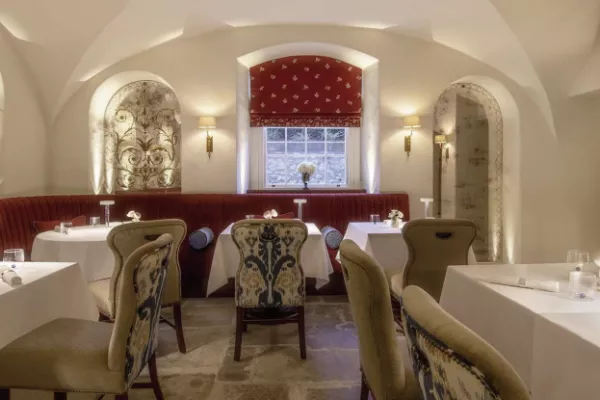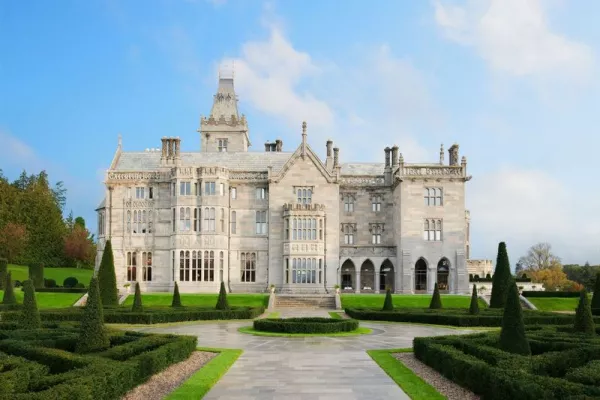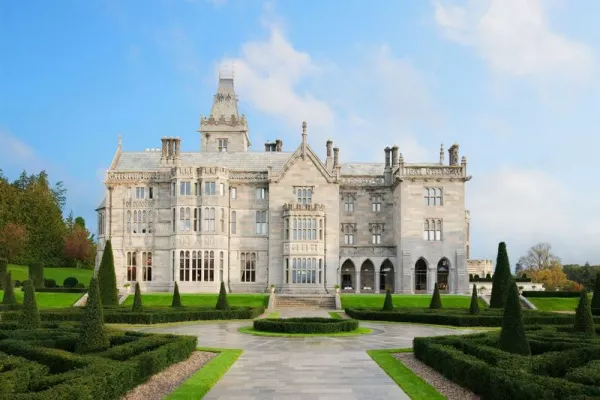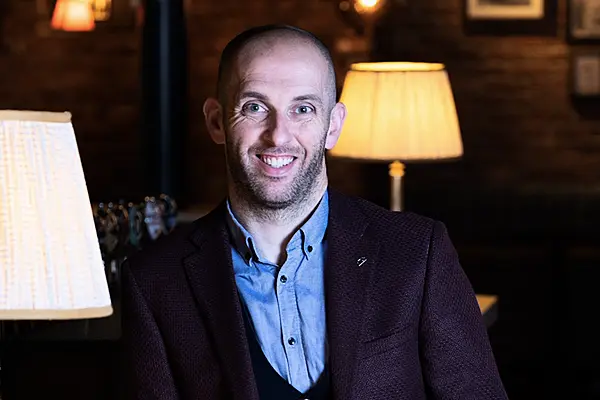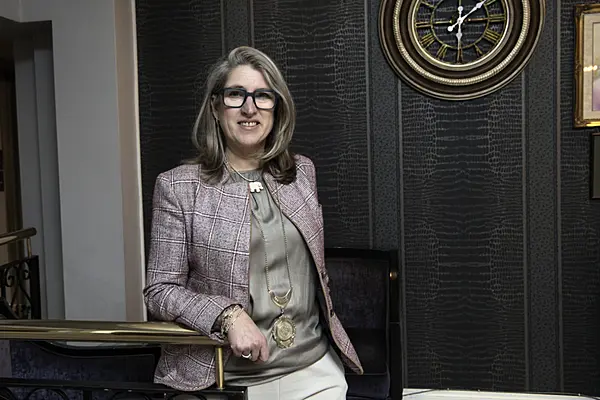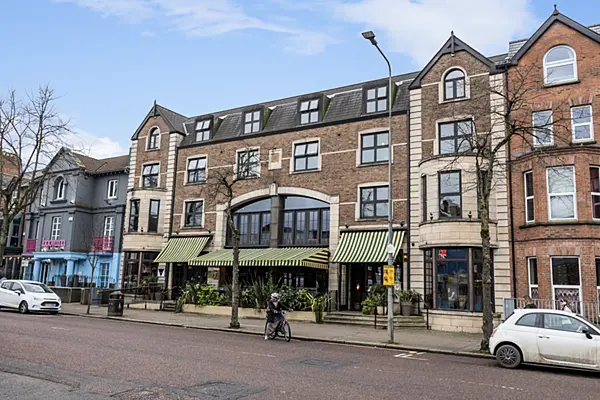Stephen Hayes is executive chef at the Cashel Palace Hotel, which reopened last year, after a multimillion-euro reboot, and was recently announced as the sole Irish hotel on Condé Nast Traveler’s Hot List for 2023. Stephen was formerly head chef of the Michelin-starred restaurant at the Cliff House Hotel, in Waterford, and burnished his skills at the three-starred restaurant De Librije, in Holland. With a focus on locally sourced produce, Stephen creates menus that reflect the very best of what Ireland – and, more specifically, Tipperary – has to offer. Here, he talks to Hospitality Ireland about studying home economics at school and forging a career from it.
This article was originally published in the Summer 2023 issue of Hospitality Ireland Magazine, in July of 2023.
Stephen Hayes is executive chef at the Cashel Palace Hotel, which reopened last year, after a multimillion-euro reboot, and was recently announced as the sole Irish hotel on Condé Nast Traveler’s Hot List for 2023. Stephen was formerly head chef of the Michelin-starred restaurant at the Cliff House Hotel, in Waterford, and burnished his skills at the three-starred restaurant De Librije, in Holland. With a focus on locally sourced produce, Stephen creates menus that reflect the very best of what Ireland – and, more specifically, Tipperary – has to offer. Here, he talks to Hospitality Ireland about studying home economics at school and forging a career from it.
Tell us about your background – where you grew up, studied, etc.
I grew up in Rathfarnham, a suburb on the south side of Dublin. Both my primary and secondary schools were Irish speaking – one in Knocklyon, and the other in Tallaght. I spent most of my childhood between those places and my grandparents’ house in Dundrum. I studied culinary arts in DIT Cathal Brugha St under the direction of lecturers such as Mairtín Mac Con Iomaire, Pauline Danaher and John Clancy.
What first drew you to food and cooking?
As mentioned, I attended an Irish secondary school in Tymon Park, Tallaght, called Coláiste de hÍde. There wasn’t many in the school – less than 150 at the time – and only 20 or so in my class. When we entered the Leaving Certificate cycle, there was only myself and one other student that wanted to take the business studies class, but that wasn’t enough to make the quota. We were offered art, music, or home economics. I had done a bit of home ec in Transition Year and quite enjoyed the cooking side of things, so decided to go in that direction. I also spent a lot of time with both of my grandmothers, who spent a lot of time cooking – I would always be there to lick the spoon or grate the cheese – so I was always involved with some aspect of the dinner, plus I was a growing lad and enjoyed to eat!
When did you first realise that you wanted to do this professionally?
I suppose that, after a couple of years in home economics, not only was I enjoying the fact that I wasn’t in the classroom environment all of the time, but the food that we cooked was actually decent. I had always wanted to do something around sport or sport science, but never earned enough points for that, so the culinary arts degree was the third choice on my CAO, and I was lucky enough to secure a place on the course.
What was your first big role?
Perhaps the title that I held at the time wasn’t the most desirable, but when I started as an intern in the Cliff House, it felt big to me. I had eaten there the previous summer, and the food completely blew my mind. The food and techniques that Martijn Kajuiter and his team were producing then was so far ahead of the rest of the country – or at least the small portion that I had seen at that point. I completed the four weeks of my internship down there and was asked to start back as a commis or demi chef de partie – I don’t recall the position, but titles have never really mattered to me. Anyway, I was thrown straight into the deep end and given the task of running the pastry section that summer with another young chef, Patrick O’Grady.
What was that like?
It was a pretty daunting task, but we made it through that summer, and I knew if I could make it through that, that I could make it through almost anything. During my time in the Cliff House, I got the opportunity to experience many exciting events and milestones. From cooking for almost 400 people in a makeshift kitchen in a whiskey distillery to helping with the process of making a cookbook [Let’s Go Disco], I learned a lot during my time in the Cliff House, from Martijn, Adriaan [Bartels], and many other characters down the years.
Talk to us about your career highlights so far – the Cliff House Hotel, De Librije restaurant.
One of the things that I am proudest of, from a work point of view, is helping to maintain the Michelin star in the Cliff House over the years that I spent there – some years as a young chef who was still very much learning the ways of the industry, and some as the head chef and leader of a team. For the team, under Martijn’s leadership, to retain the star in Ardmore is amazing.
Of course, my work in the Cliff House led me to the Netherlands and to work in De Librije, which was one of the most invaluable learning experiences of my career to date – a completely different atmosphere, and also a different ball game when it came to cooking. I am still in touch with many of the team [members] that I worked with in De Librije, which is also very important to me.
Tell us about the refurbishment of the Cashel Palace.
The first time I visited Cashel, my partner Eimear and I dropped into Mikey Ryan’s for a pint, followed by dinner in Chez Hans. The decor and atmosphere in Mikey’s was buzzing, especially since it was a midweek evening at 5.30 or so, but the place intrigued me, so I decided to meet Adriaan and have a look at the hotel.
At that point, the renovations of the main house were under way, but new developments on either side – where the spa wing and garden wing are now situated – had not begun. We walked through the building site, where there was dirt piled higher than the windows of the Bishop’s Buttery [restaurant], all the flagstones had been removed for cleaning, and I was told that the hotel planned to open in 12 months’ time – around March 2020, which seemed very fast.
Obviously – and, in hindsight, thankfully, for the completion of the project – Covid-19 struck and everything was delayed. This was a frustrating period, where we tried some takeaway food offerings from Mikey Ryan’s, helped with some local charities, but, thankfully, got to visit some of our new suppliers. Eventually, after Covid began to cool off, the hotel renovations began to take shape and we opened on 1 March 2022.
What’s different now?
Since opening, we have managed to build a team in all areas of the hotel that can work together in harmony, with the best interests of the hotel and its guests as the top priority. There have been many accolades along the way, but the best feeling is to have a full hotel, busy restaurants, and a happy team. Thankfully, the renovations have improved the standard of the hotel, and that gives the team immense pride to call the Cashel Palace their workplace.
What did it mean to be the sole Irish hotel on Condé Nast Traveler’s Hot List for 2023?
Obviously, Condé Nast is one of [the most], if not the most, distinguished travel magazines in the world, so, naturally, we were delighted to be included in the Traveler’s Hot List. There have been so many great accolades achieved by the team in such a small space of time. Mikey Ryan’s was named Pub of the Year from Good Food Ireland. The Bishop’s Buttery was listed in the Michelin Guide as well! It’s a real acknowledgment for all of the hard work that the team have put in since the opening of the hotel.
Tell us about the food at the Cashel Palace – the ethos, sourcing, etc.
I like to think of the food in the Cashel Palace as simple, well-sourced and - prepared food that isn’t too sophisticated to understand. We work very much from the basics of French cookery and source many ingredients from the locality, whether it be Cashel or Tipperary, even further afield in Munster, or outside – if the product is good, we use it.
I’ve worked in places before, where I feel that when the guest gets around to eating a particular dish, that it had been through so many stages of manipulation that the final product didn’t represent or champion the original ingredient/ingredients. Now I encourage the team to allow guests to eat with ease, without having to think too much into what is on the plate. A super-fresh piece of fish, a nice vegetable garnish, a smooth and flavourful purée, a good sauce is all that you really need, in my opinion. That’s how we operate in the Bishop’s Buttery.
For breakfast, it’s similar – we source all of the items for our signature breakfast from Cashel or the surroundings. For afternoon tea, we serve finger sandwiches and cakes that resemble cakes – not too much glazing and dipping involved. We have the classics on the menu, such as cucumber finger sandwiches and choux buns and opera cakes – simple yet delicious.
What makes a great restaurant?
The synergy between the front of house and the kitchen. There needs to be an understanding and mutual respect from both teams to one another – a duty of care, almost. The restaurant cannot operate without both teams working like a well-oiled machine, and I feel that is where a lot of restaurants can potentially fall short.
Historically, the relationship between the kitchen and front-of-house team hasn’t always been the smoothest, but I am delighted that, in the hotel, we have a great relationship with each other. When the hotel opened back in March 2022, we did not have a restaurant manager in situ, so a lot of the training of the restaurant team came from the kitchen, as well as the food-and-beverage team. This allowed for both teams to work openly and transparently together, to achieve the best-possible outcome for the restaurant and its guests.
What are the changing trends in hospitality – people’s expectations, new elements, etc.?
Guest expectations are always high, especially in the five-star luxury market. I think that, after Covid, there was a period of grace, where guests understood the struggles of our industry and were more understanding. I think it was a wake-up call for everyone, and probably for the better.
There is still a very strong emphasis on healthy eating, and certain dietary requirements are becoming a more regular thing. Of course, gluten-free diets and vegetarians are the most popular, but we are seeing more and more vegans. I guess that eating responsibly and managing the amount of red meat consumed is top of people’s agendas at present.
What are the major challenges at the moment?
Staffing. The past few years have been particularly challenging with staff, especially in finding trained professionals to work in the industry. Covid didn’t help, obviously, but there are certain things that are within our control that we can do to help entice new recruits to the hospitality sector. I think that we all have a responsibility to eradicate the old-school mentality in kitchens, and that there is a balance of males and females. Personally, I see absolutely no difference between a male and female chef – they are just a chef of equal ability and standing.
What are the main opportunities?
I still believe strongly that our industry is one of the best. The opportunities are the same now as when I entered it. If you can cook, you can cook anywhere in the world and learn all of the different cuisines and techniques along the way. There is also a camaraderie in our industry that you don’t find in any other industry. Everywhere you go in the world, people in the industry look out for each other, which is great.
Any other plans on the horizon for the next year or so?
Head down, and keep pushing alongside the team, trying to provide a great dining experience across the different outlets in Cashel Palace.
CASHEL PALACE AT A GLANCE:
How many rooms? Forty-two.
How many dining options? Five: the Bishop’s Buttery, the Queen Anne Room, the Terrace, Mikey Ryan’s, and our banqueting offering. On average, how many covers (for lunch and dinner)? Throughout the hotel, it’s pretty hard to put a number on things. On a busy Saturday, if we have a wedding in house, we are more than capable of serving up to 1,000 guests over the course of the day.
Number of staff members – front and back of house? I have approximately 35 in the kitchen, over four different spaces, including kitchen porters. Front of house is hard to put a figure on, as we have many part-timers that work on wedding days, etc.
Signature dishes?
Each kitchen has their own head chef, so I have the following chefs in the following positions:
- Darren Mulvihill, exec sous, takes care of banqueting and oversees the rest of the operation with me. The signature dish in banqueting is probably our crab dish with tomato gazpacho and basil oil. Almost every wedding has this one.
- Darragh O’Flaherty, head chef of the Bishop’s Buttery – his Shepherd’s Store [cheese] agnolotti is super local and hasn’t come off the menu since we’ve opened.
- Ciaran Tedford, head chef of Mikey Ryan’s, has a wonderful sharing lamb plate on the menu that is very seasonal. It’s the lamb rack served with braised shoulder, couscous, flatbreads, and a fresh pomegranate and fennel salad.
- Alicia Travier, head pastry chef in events and banqueting, looks after a lot of different aspects of pastry, including afternoon tea and room service desserts, to name just a few. Her peanut parfait with Taïnori chocolate crémeux is always a winner.
Read More: Hospitality Ireland Summer 2023: Read The Latest Issue Online!
